Deep in the heart of Kentucky lies the largest forest in the state. Spanning over 708,000 acres, this sprawling wilderness is home to mystery and adventure. The forest is home to towering trees that cast tranquil shade, bubbling brooks that sing soothing hymns, and a variety of flora and fauna that flourish in its fertile lands.
From black bears roaming through the woods to playful otters splashing in the creeks, the hardwood forest boasts a host of wildlife that’s sure to delight. Surrounded by rare bird species soaring high above the treetops, it’s an ideal destination for adventurers and nature enthusiasts alike.
Whether you’re a seasoned hiker looking for a challenge, or an amateur naturalist seeking wonder, the forest has something for everyone. Join us as we explore this fascinating realm and uncover the hidden treasures that call the largest forest in Kentucky home.
A Majestic Overview
Daniel Boone National Forest is the largest forest in Kentucky. As previously stated, it has over 708,000 acres of rugged terrain. It has high forested hills, soaring sandstone cliffs, and narrow ravines. But that’s not all.
While hiking through the forest, you’ll encounter breathtaking natural stone arches, waterfalls, and caves. These scenes will make you feel like a true explorer. Visitors value the forest’s recreation opportunities, natural beauty, and diverse animals.
Swim in Laurel River Lake, Cave Run Lake, or Red River Gorge Geological Area while exploring Clifty Wilderness Area. And for the history buffs out there, Cumberland Falls State Resort Park and Natural Bridge Resort Park, both located within the forest, give a glimpse of the area’s rich history.
But the forest isn’t just for tourism. Mature pine and hardwood trees thrive on lands once cleared by logging, mining, and farming. The diversified woodland offers suitable habitats for a variety of animals. Expect to see:
With the forest also fostering the growth of various rare flowering plants, like the wild white fringeless orchid and white-haired goldenrod, your hike will be filled with new discoveries and surprises at every turn.
10 Animals Living in the Largest Forest in Kentucky
Daniel Boone National Forest is home to many animals. Here are 10 of the most common residents:
1. White-tailed Deer
Watch for white-tailed deer as you trek through Daniel Boone National Forest. These magnificent creatures, also known as Virginia deer, roam throughout North, Central, and South America.
As their name suggests, they are easily identified by the snowy hairs under their tail and hindquarters. Their size varies based on their habitat; they’re larger in relaxed areas and rural soil but smaller in treats and jungles.
Their ruddy brown to grayish-brown bodies and large ears are stunning. Catch a glimpse of them in open areas and the woods during the summer.
In the winter, they head to yards where food and protection from cold winds are available. With rapid reproductive abilities, their numbers can multiply within a year.
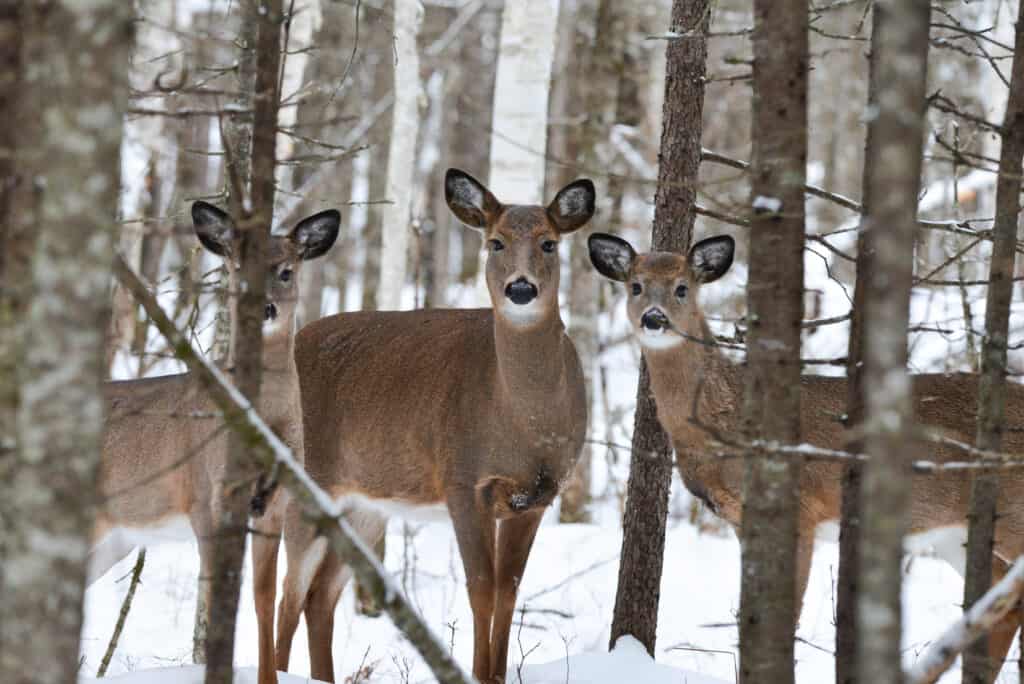
Even during the coldest of days, wildlife finds beauty in nature. These white-tailed deer were spotted in a winter wonderland.
©Rebecca C. Photography/Shutterstock.com
2. Northern Cardinal
The male cardinals are especially striking with their vibrant red body, making them hard to miss. They visit the forest during their migration to Ohio. In contrast, female cardinals have brown bodies with red accents, adding sharpness.
Cardinals are hardy birds that need little to survive and thrive. They don’t shed their feathers in the winter and continue to whistle beautiful songs in the morning. While fewer birds sing songs during this time, females sing while sitting in their nests, which is delightful to listen to.
During mating season, male cardinals sing more complex songs, and females flock toward them. They’ve also been known to confuse their reflections in vehicle mirrors or other glossy surfaces and spend hours battling these gatecrashers.

Look at this beautiful northern cardinal! With its bright red feathers and sharp black markings, it’s one of the most recognizable birds in North America.
©iStock.com/Lynnae_Lowe
3. Red Fox
If you want to spot the red fox, visiting Daniel Boone National Forest could be your chance. These agile creatures are least concerned about population stability, so the IUCN lists them in the “Least Concern (LC)” category.
Unfortunately, their skill to adapt to new environments has made them one of the “world’s 100 worst invasive species.” For instance, in Australia, they have hurt native birds and mammals.
In pursuing adventure, always remember that these foxes consume small rodents, birds, rabbits, vertebrates, and reptiles. Even young ungulates could be targets.
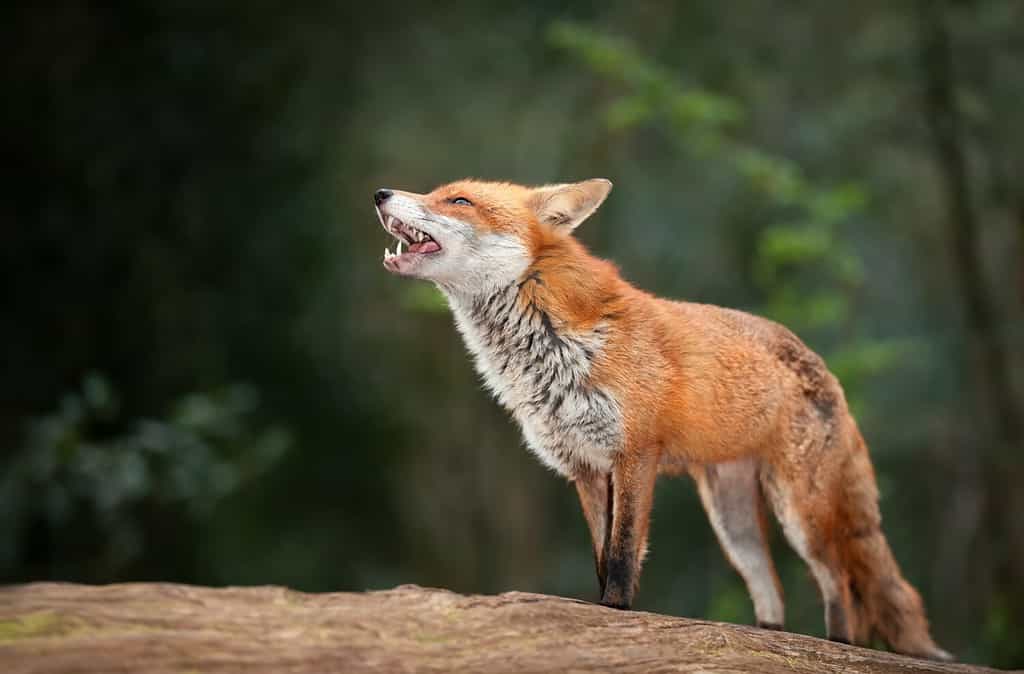
This crafty red fox looks as if it’s planning its next move!
©Giedriius/Shutterstock.com
4. Woodchuck
The Daniel Boone National Forest is home to the wild and adventurous woodchuck, a worthy rodent. Carl Linnaeus discovered this groundhog belonging to the giant squirrel family in the mid-18th century.
The woodchuck thrives throughout Kentucky’s lowlands. With a length of 16.5 to 27 inches and a weight of up to 13.9 pounds, it’s easy to spot these creatures waddling around.
During autumn, the woodchuck’s weight increases significantly through stored fat utilized during hibernation. Keep your eyes peeled for these furry critters while hiking through the Daniel Boone National Forest, the perfect reminder of nature’s wondrous intelligence.
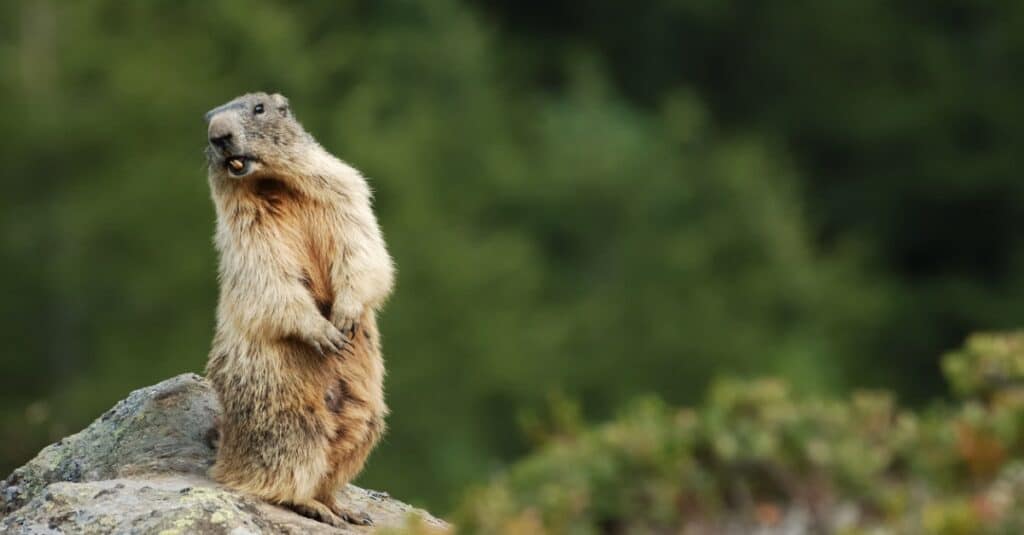
Groundhogs have squirrel-like faces and stand about two feet tall.
©iStock.com/gilles_oster
5. Eastern Raccoon
As you explore the vast wilderness of the Daniel Boone National Forest, keep your eyes peeled for the lively eastern raccoon. This curious and intelligent creature roams freely throughout the park’s prairies, marshes, and forests. With a medium-sized body and distinctive black “mask,” they are easily identifiable.
When darkness falls, these nocturnal foragers come out to play. They snatch frogs, fish, and other aquatic creatures using their nimble paws for hunting. But they are far from picky eaters, also eating insects, mice, plants, and fruits.
Watch out, though – these rascals raid nests for eggs. Watch your surroundings and enjoy the thrill of spotting this mischievous animal in its natural habitat.
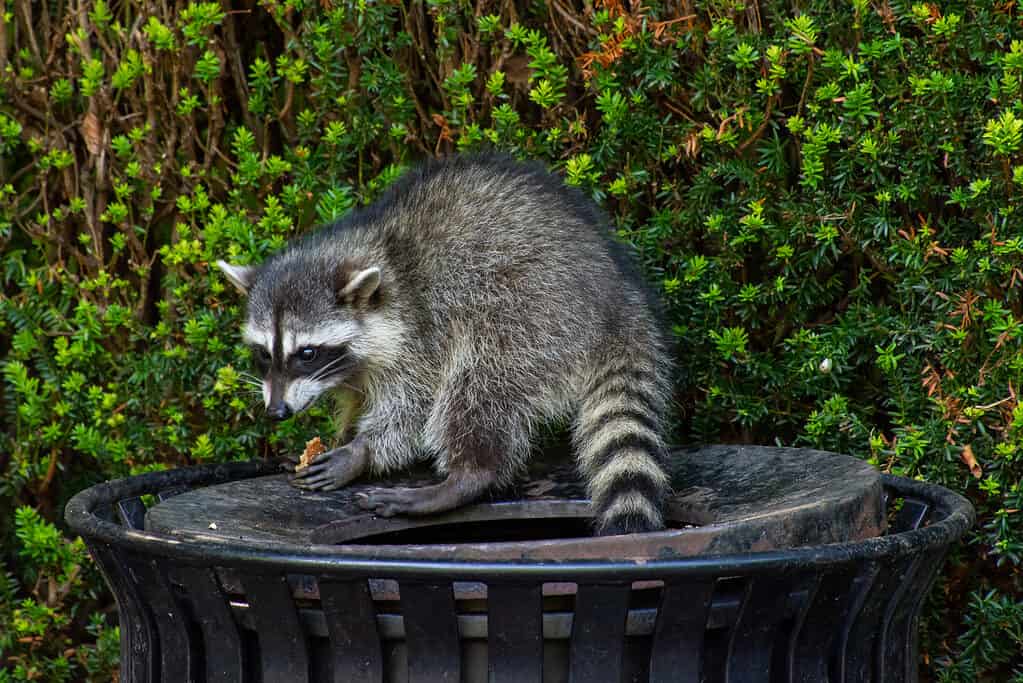
With its unique black mask and fluffy ringed tail, this furry creature is sure to be a favorite among nature lovers.
©kingma photos/Shutterstock.com
6. Muskrat
Part rodent, part aquatic acrobat, this semi-aquatic creature can be found in wetlands throughout North America. The muskrat has even been introduced to other countries.
They’re no strangers to human interaction, considering they’re hunted for their fur and food source. But their impact on wetlands ecology can’t be overstated. They’re versatile creatures that adapt to many lifestyles. Their diet is just as varied.

This muskrat is enjoying his lunch and getting all the nutrients he needs from this marshy environment.
©Anton MirMar/Shutterstock.com
7. Virginia Opossum
Consider yourself lucky if you see the Virginia opossum in the Daniel Boone National Forest. This North American marsupial is breathtaking. Around the size of a domestic cat, the Virginia opossum is night-loving and mostly keeps to itself. However, don’t let its shyness fool you; this animal is a survivor and adapted to living in various habitats and even near urban areas.
The opossum’s expert foraging skills make it a known visitor to garbage sites, so keep your food stored properly. Originally intended as a food source during the Great Depression, the Virginia opossum can now be found in most Pacific Coast parts. It has expanded northward into British Columbia, Canada.
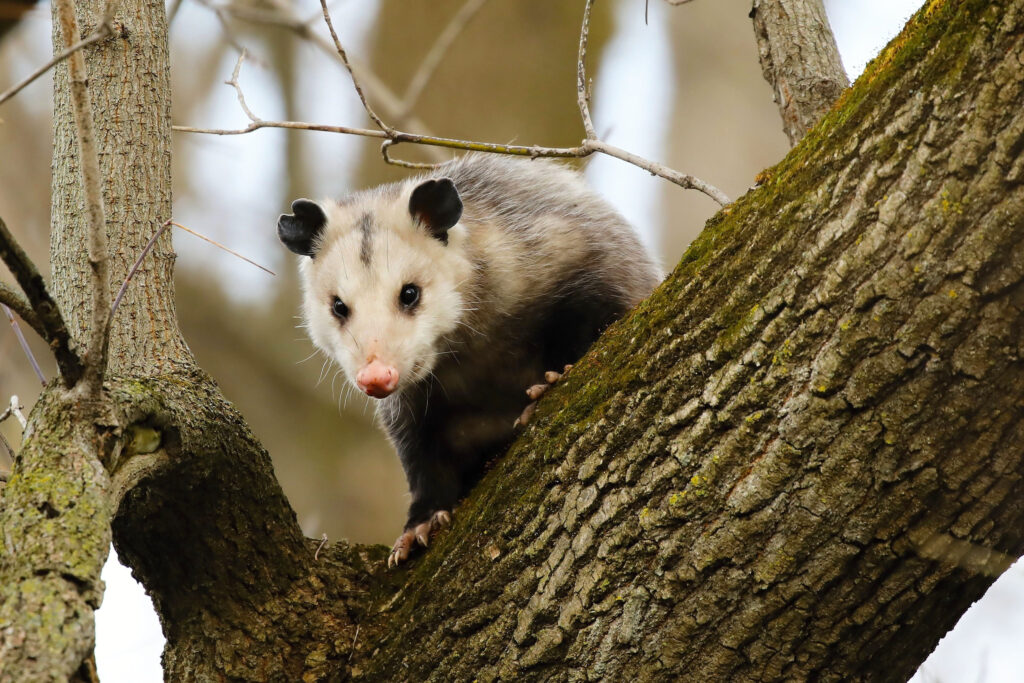
Look at this cute little opossum enjoying the view from up high. They can often be found in trees while they search for food or try to escape predators.
©Karel Bock/Shutterstock.com
8. Gray Fox
This playful canid used to be the most common fox in the eastern United States, but its numbers have shrunk due to deforestation. Despite this, the gray fox still reigns supreme in the Pacific US states.
One of the unique traits of gray foxes is their ability to climb trees, which no other American canid can do. You’ll recognize this fox by its grizzled upper parts, black stripes on its face, and strong neck.
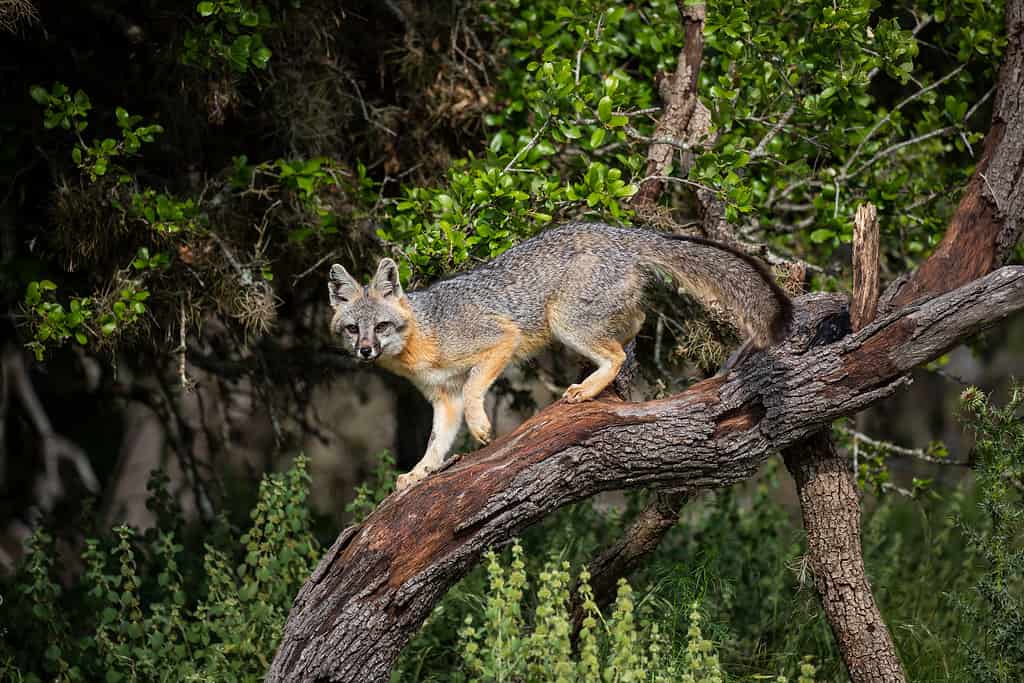
The sly gray fox perched atop the lush evergreen tree, ready to leap into action and explore its natural habitat.
©Danita Delimont/Shutterstock.com
9. Blue Jay
This passerine bird, found throughout North America, thrives in forests and residential areas. Its striking U-shaped collar sets it apart from other avian species in the area.
Don’t worry about identifying males from females – they’re similar in size and plumage. Plus, you’ll recognize its signature blue feathers no matter the season. Four subspecies of blue jay live in North America, but all have the same adventurous spirit.

The beautiful blue jay sits atop its perch, surveying the world below. Its bright blue and white feathers glistening in the sun.
©iStock.com/BrianEKushner
10. Tufted Titmouse
The tufted titmouse is a feathered warrior living in the Daniel Boone National Forest of Kentucky. The bird stands out with a striking black forehead and gray plumage on its upper body. However, the signature tuft of gray feathers on its head makes it something special.
This adventurer measures up to six inches long, making it an agile forest flier. The tufted titmouse feeds on insects, nuts, seeds, and nests in tree cavities. Sadly, this bird’s population has decreased by more than 1.5% annually across the US since 1966.

The tufted titmouse is so inquisitive, it’s hard not to stare back.
©Rich Waite/Shutterstock.com
Types of Trees Found in the Forest
It’s not just the animals that make this forest so special. The Daniel Boone National Forest is home to a wide variety of trees and lush vegetation that live within it. The most common include:
Beech Trees
Beech trees are common in this forest. They have short trunks and rough, gray bark. They are widely known for their pointed oval leaves that turn golden brown in the fall. They can grow up to 100 feet.
Sugar Maples
Easily recognizable in the forest for their vibrant red, orange, and yellow hues, sugar maples are medium-sized trees with rounded crowns and straight trunks. They provide high-quality wood and are the primary source of maple syrup.
White Pines
White pine trees are the tallest in the Eastern United States and can grow up to 230 feet tall. They have evergreen foliage with soft, flexible needles in five bundles. They are commonly used for commercial purposes such as building and construction.
Hemlock Trees
Hemlock trees are among the oldest tree species in the Eastern United States. They have a thin, dark brown, rough bark and flat green needles that give a citrusy aroma when crushed. They are popular for their ornamental value.
Types of Oak
Daniel Boone National Forest has several oak trees, including red, black, and white. They are deciduous and produce acorns that provide food for the creatures that call this forest home. They are famous for their use in furniture, flooring, and construction.
Hickory Trees
Hickory trees have a special bark that appears in small, narrow plates. They have compound leaves with a medium to dark green color. Hickory trees play a vital role in wildlife lives in the forest because they produce edible nuts known for their sweet flavor.
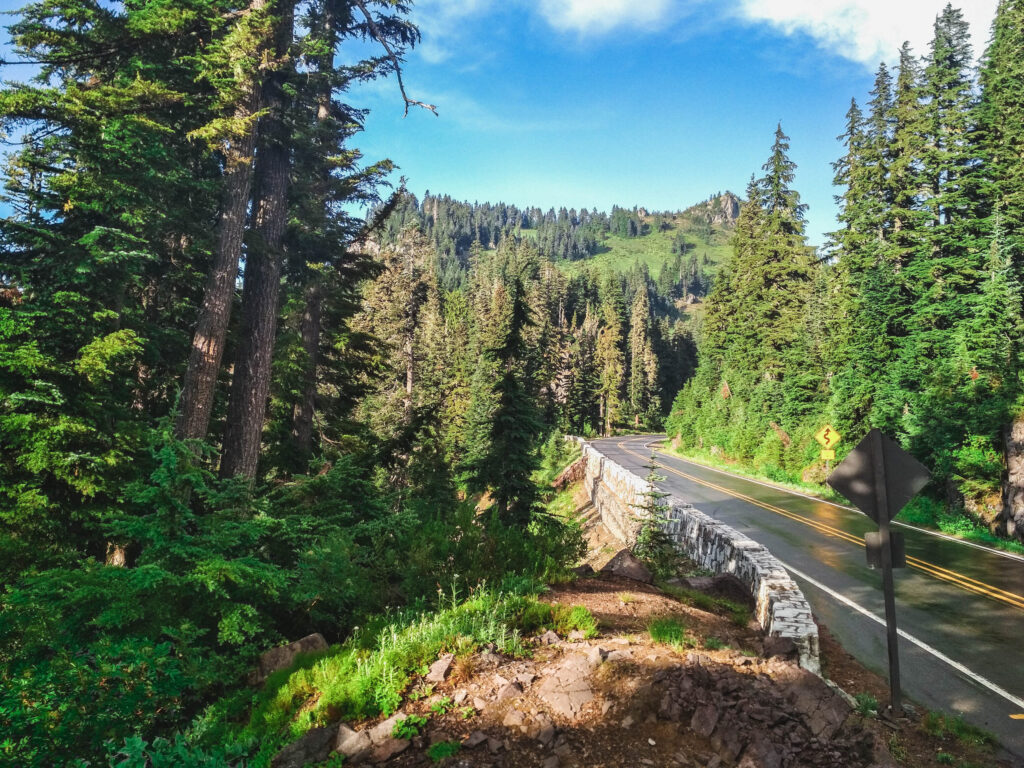
Take a deep breath, close your eyes, and let the beauty of nature surround you.
©Velimir Zeland/Shutterstock.com
Daniel Boone National Forest Unforgettable Adventures
Trekking Through the Wilderness: Hiking Trails
There’s no better way to experience the forest’s breathtaking beauty than by exploring its extensive hiking trails. Some popular options include:
- Sheltowee Trace National Recreation Trail – 323 miles of scenic trails traversing the forest.
- Red River Gorge Geological Area – offering over 100 miles of trails, perfect for hikers of all skill levels.
- Natural Bridge State Resort Park – featuring a 2.5-mile hike to the iconic Natural Bridge, a massive sandstone arch.
On the Water: Boating, Fishing, and Swimming
For water enthusiasts, the forest’s numerous lakes, rivers, and streams provide endless opportunities for fun and relaxation.
- Boating: Rent a canoe, kayak, or pontoon boat to explore Cave Run Lake, Laurel River Lake, or Lake Cumberland.
- Fishing: Cast a line in the Red River or Big South Fork River, teeming with smallmouth bass, rainbow trout, and catfish.
- Swimming: Take a refreshing dip in the cool waters of Cumberland Falls State Resort Park or Laurel River Lake.
Scaling New Heights: Rock Climbing and Ziplining
Thrill-seekers will be delighted by the forest’s exhilarating rock climbing and ziplining opportunities.
- Rock Climbing: Conquer world-class climbing routes at Red River Gorge or Muir Valley.
- Ziplining: Soar through the treetops on a canopy tour at Red River Gorge Zipline or Natural Bridge Skylift.
Ways to Preserve the Environment and Protect this Beautiful Natural Area
The Daniel Boone National Forest is a remarkable destination for adventurers and nature lovers. With sprawling landscapes, hiking trails, and stunning waterways, this beautiful natural area is a treasure trove worth preserving. Here are some ways to preserve the Daniel Boone National Forest and protect this natural paradise.
- Stay on trails and respect wildlife habitats to minimize damage to plants and animals.
- Dispose of all trash responsibly when packing in and packing out.
- Respect grazing land and keep pets under control to avoid disturbing wildlife.
- Use certified firewood instead of collecting it from the forest, as it spreads diseases.
- Avoid single-use plastics and opt for reusable containers or bags instead.
- Camp only in designated areas to prevent erosion and protect delicate landscapes.
FAQs
Can I Camp in the Daniel Boone National Forest?
You sure can. With many campsites ranging from basic to deluxe, there’s something for everyone. Remember to respect the rules and practice ‘Leave No Trace’ principles.
Are there Guided Tours or Educational Programs in the Forest?
Absolutely. The U.S. Forest Service offers interpretive programs, guided hikes, educational programs, and other events annually. Check out their website or ask a friendly ranger for more information.
Can I Bring My Furry Buddy to the Daniel Boone National Forest?
A: Yes, you can. Bring along your pup and enjoy the forest with a four-legged friend. However, leash your pup and clean up after them to keep the forest safe and clean.
When is the Best Time to Explore the Forest?
Any season is exceptional when exploring Kentucky’s largest forest, each offering unique beauty. Spring and fall are fantastic, with stunning wildflowers and colorful foliage. Take advantage of the warm temperatures during the summer by participating in refreshing water activities.

Come explore the wonders of nature in Kentucky’s Daniel Boone National Forest. It offers a variety of activities for outdoor enthusiasts.
©iStock.com/James Geisler
Thinking of Planning a Visit?
The Daniel Boone National Forest is a true wonder of nature set in Kentucky’s beautiful hills. From its pristine rivers and lakes to its lush meadows, it’s easy to see why this is one of the Bluegrass State’s most treasured areas. Besides the breathtaking natural beauty, visitors will be surprised by the many species inhabiting this incredible landscape.
Whether looking for a peaceful spot to contemplate or adventurous terrain to explore, Daniel Boone National Forest has something to offer everyone. Take advantage of this amazing corner of Kentucky. Take some time today and discover all that the largest forest in Kentucky has to offer.
Where is Daniel Boone National Forest Located on a Map?
Daniel Boone National Forest is the largest forest in Kentucky with more than 700,000 acres of rugged terrain to explore and observe. This majestic forest is spread across 21 counties of eastern Kentucky and has every outdoor activity imaginable for thrill-seekers and families alike.
The photo featured at the top of this post is © iStock.com/Alexander Fattal
Thank you for reading! Have some feedback for us? Contact the AZ Animals editorial team.






